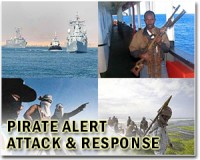| . |  |
. |
Mogadishu, Somalia (UPI) Jan 19, 2011 Even piracy suffers from inflation. Somali pirates are reported to have hiked ransom demands for hijacked ships by as much as 60 percent in recent months. The One Earth Future foundation said in a January study that the average ransom paid to pirate gangs in 2010 went up to $5.4 million per ship from $3.4 million in 2009. That coincided with a report by the International Maritime Bureau, an arm of the International Chamber of Commerce which monitors piracy worldwide, that seaborne marauders seized a record 1,181 hostages in 2010 amid an escalation in hijackings in the Gulf of Aden and eastward into the Indian Ocean. All told, 53 vessels were hijacked around the globe, all but four of them off Somalia, the bureau's monitoring center in Kuala Lumpur, Malaysia, reported. The foundation reported that a record ransom payment to pirates was set Nov. 6 when $9.5 million was paid for the release of the Samho Dream, a 300,000-ton oil supertanker owned by SH Tankers Ltd. of South Korea. The vessel, en route to the United States with a crew of 24, was hijacked April 4, 2010, 930 miles southeast of the Gulf of Aden while carrying a cargo of Iraqi crude worth $170 million. Ransom demands have risen steadily since the Somali pirate plague began in earnest in 2005. Shipping industry analysts say that benchmarks have often been set by ship owners giving in too quickly to demands by pirates and paying out more than hijackers were aware might be available. Before 2005, the average ransom was $150,000. Anna Bowden, author of the One Earth Future study, said that in recent times the release of ships and their crews has taken longer as the pirates' ever-growing ransoms ran up against insurers' reluctance to meet their demands. The last four ships released in 2010 were held for an average of 150 days compared to an average of 55 days for vessels released in 2009, the survey observed. It noted, too, that the pirates may have hiked ransom demands because it has become increasingly difficult and risky to seize ships due to the presence of international navy flotillas guarding shipping corridors and increased security aboard commercial ships using the shipping lanes that link the Mediterranean and Red Seas to the Indian Ocean. The number of successful hijackings in Somali waters fell from 52 in 2009 to 44 in 2010. Another factor in that regard may have been that ship owners are increasingly sending vessels the longer route around the Cape of Good Hope on the southern tip of Africa to avoid the dangerous waters off Somalia. The foundation study estimated that shipping operators were spending between $2.3 billion and $3 billion extra per year on the basis that some 10 percent of voyages that had previously used the Suez Canal and the Red Sea were being re-routed around the cape. The IMB report said the number of vessels hijacked and crewmembers taken hostage in 2010 "are the highest we have ever seen" since the organization began monitoring attacks in 1991. "The continued increase in these numbers is alarming," observed Pottengal Mukandan, director of the IMB reporting center. That report also covered other regions hit by pirate attacks, notably the Malacca Strait between Malaysia and Indonesia, the waters off oil-rich West Africa and the Indian Ocean off Bangladesh. Overall, the global maritime watchdog reported there were 445 pirate attacks worldwide in 2010, a 10 percent increase over 2009. Eight crewmen were killed, all by Somali pirates. Thirty vessels were boarded by pirates off Indonesia, 21 off Bangladesh and 13 off Nigeria, most of them near Lagos, the oil-rich country's busiest port. Most of these involved robbery rather than seizure for ransom. Meantime, the Somalia pirates have been expanding their area of operations eastward deep into the Indian Ocean and southward along the coast of East Africa, largely because of the naval; presence off Somalia. The pirates there, who currently hold at least 28 ships and 654 crewmembers in their lairs along Somalia's 1,000-mile coastline, tried to seize two vessels in the Mozambique Channel over Christmas. That's the furthest south they have ever struck, underlining how they are constantly moving into waters not protected by international naval forces.
Share This Article With Planet Earth
Related Links 21st Century Pirates
 S. Korea warship pursues hijacked vessel
S. Korea warship pursues hijacked vesselSeoul (AFP) Jan 16, 2011 South Korea has ordered a warship to chase a cargo ship hijacked by suspected Somali pirates, a Seoul official said Sunday, as President Lee Myung-Bak urged "all possible measures" to rescue the 21 crew. The destroyer Choi Young was sent to pursue the Samho Jewelry, a 11,500-tonne South Korean chemical freighter seized in the Indian Ocean, a presidential spokeswoman said. Lee held an em ... read more |
|
| The content herein, unless otherwise known to be public domain, are Copyright 1995-2010 - SpaceDaily. AFP and UPI Wire Stories are copyright Agence France-Presse and United Press International. ESA Portal Reports are copyright European Space Agency. All NASA sourced material is public domain. Additional copyrights may apply in whole or part to other bona fide parties. Advertising does not imply endorsement,agreement or approval of any opinions, statements or information provided by SpaceDaily on any Web page published or hosted by SpaceDaily. Privacy Statement |